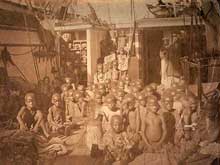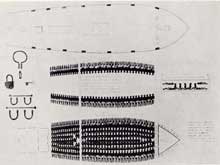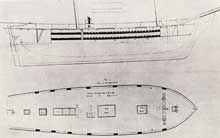
This image is one of the earliest photographs of Africans being rescued from a slave ship by the British Royal Navy. Click image for larger view and image credit.
Page from an instruction manual for the distribution of slaves aboard a 19th century slave ship. Click image for larger view and image credit.
The Illegal African Slave Trade
July 8 – July 22, 2006
Toni L. Carrell, Ph.D.
Ships of Discovery
Veronica Veerkamp
Windward Media
By the first quarter of the nineteenth century most European and American nations had officially recognized the barbaric nature of the African slave trade and had signed treaties in support of its elimination. The economic incentives that created and supported the trade, however, did not end and, in fact, dramatically increased. For the next fifty years, every year tens of thousands of Africans continued to be kidnapped and smuggled to the Americas.
Until the 1850’s, the British Royal Navy labored virtually alone to interdict slaving vessels and stop the flow of human cargo. In spite of their efforts, Africans were still being kidnapped and smuggled out in increasing numbers to satisfy a seemingly insatiable need for laborers in the plantation economies of the Americas and elsewhere. The vast majority went to Brazil and Cuba, where sugar plantations were booming, but many were still being smuggled into the Southern States through Texas, Louisiana, and Florida. Many former American slave traders took their ships to Cuba and continued to operate under the protection of Spanish registry. Coincidentally about this time, Spain lifted local restrictions on foreign trade, and a flurry of Catalonian entrepreneurs entered the lucrative slave trade, or started sugar plantations and rum factories, especially in Cuba. Vast fortunes were made and titles were purchased by these families, today some of the wealthiest in the world.
Abolitionists in the U.S., Spain, Great Britain, and elsewhere were beginning to have an impact on their governments’ enforcement policies, which until then were very lax or non-existent. Although recalled after a few years for his unpopular stance, the Spanish Intendant (an administrative official to the monarch) in Havana in the early 1840s had a policy of strict adherence to the provisions of the treaties. A half-dozen U.S. Navy ships joined the British interdiction fleet off the coast of Africa. While still refusing to allow foreign boarding of ships with American registry, the U.S. and other countries began to participate in international tribunals to try smuggling cases. Spain finally started pressing its colonies to develop a substitute labor system, and other European countries followed suit. Portugal, the first country to enter the African slave trade, was the last country to sign the slave-trade treaties, and the last to actively enforce the ban.
By the 1860’s it was becoming riskier and less profitable for ship owners to engage in the slave trade. With the abolition of slavery in the U.S. after the end of the American Civil War there were few viable markets left. For the first time, an American Captain was tried and convicted of a capital crime related to the trade. The last known African slave trader was intercepted by the Royal Navy in 1871.








